The glory of virtue
This is San Beda University. Built in 1925, the complex was designed as an abbey residence for the monks and a dormitory school for students, joined together by the church at its center. The low-rise balusters are evidence that the churchgoers at that time were mostly little schoolchildren.
However, this was not the site of the original school, El Colegio de San Beda. The previous location was at nearby Arlegui Street, established in 1901. The growing number of students required a larger campus.

George Asp, a Swedish architect, designed the church in the Neo-Gothic style. Its interior would soon be filled with the work of some of the most gifted creators of sacred art. The patron image of Our Lady of Montserrat was an original piece brought from Spain in 1895. Renowned Filipino sculptor Maximo Vicente carved the image of Santo Niño de Praga, to whom the church is also dedicated. Decorative features on the ceiling were executed by Dom Salvador Alberich, OSB, who cleverly disguised some of the overhead air vents as medallions.
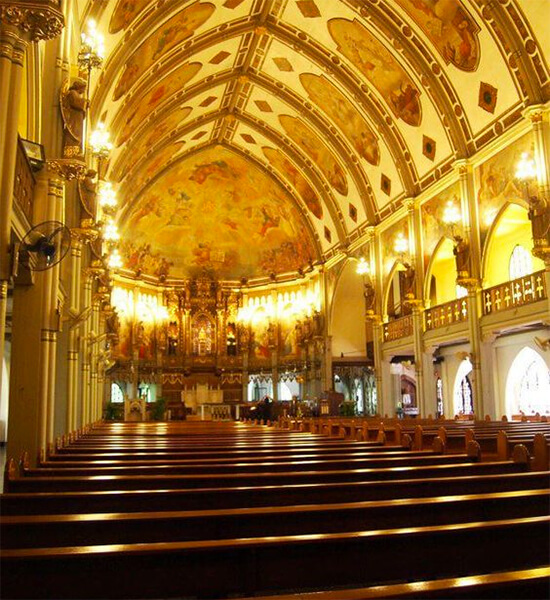
Looking up at the ceiling and towards the altar, the church that also serves as the university chapel reveals its majestic artworks. Even in dim light, this place of prayer glows inside with a golden warmth.
These breathtaking paintings were created by Father Lesmes Lopez, OSB, who also painted extensively for other Benedictine monasteries in his native Spain and in Australia. He came in 1930 to work on this church in Manila. Often of fragile health, he would live and die here, buried just outside the church to which he gave so much of himself and his talents.

Above the nave, the ceiling is lined with 16 paintings, all of remarkable scale—each measuring about 16 feet high and nine feet wide. At first, one might attempt to identify the saints in these images, painstakingly mounted over 50 feet above the church floor. However, these are not saints but mostly personifications—or rather, allegories—of virtues.
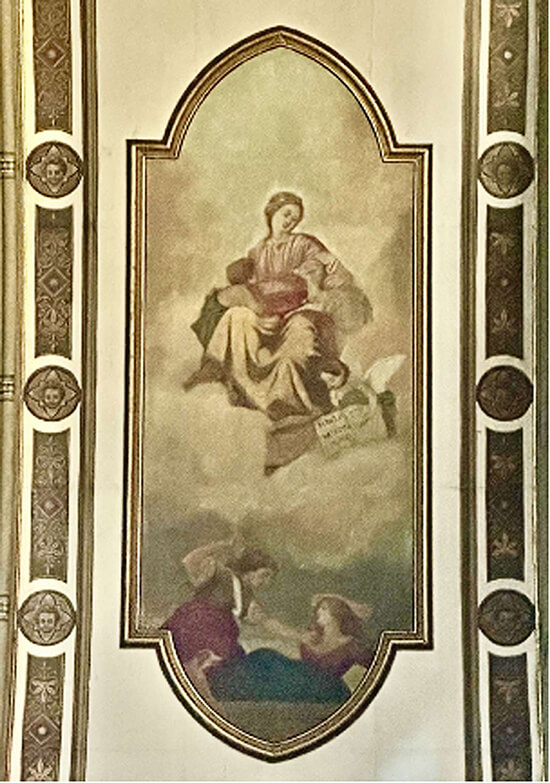
Reading the symbolism in each painting takes some time and care. The representation of the virtue floats among ethereal clouds, while below is a story where the virtue could be applied.
Starting from the left, closest to the door of the chapel and leading towards the altar, portrayed are Meekness, Penance, Prudence, Fortitude, Faith, Religion, Mystic Theology and The Last Things. On the opposite side are Peace, Innocence, Temperance, Justice, Hope, Charity, Theology and The Church.

Directly below each of these allegories are the Stations of the Cross, which crown the arches of the clerestory, the upper part of the nave. They are arranged in counterclockwise order beginning from the first arch to the left when facing the sanctuary, above one of the two impressive pipe organs. Among the rich detail, the faces appear quite emotive.
On either side of the main retablo, almost like a semi-cyclorama, are eight paintings of smaller but still impressive scale referred to as The Infancy Narrative—the story of Christ’s childhood. Poignantly rendered, they recount the tender and significant moments of the Holy Family, from the Annunciation to Jesus as a boy preaching at the temple.
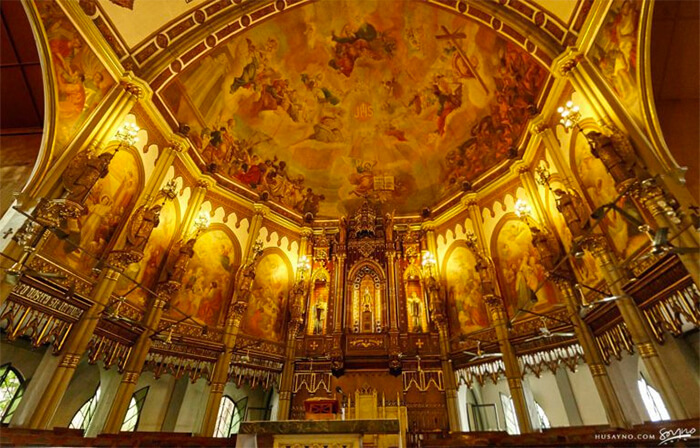
Oh, but the half-dome above! This forms the apex to which all the other artworks find their reference. It is as if the clouds parted and offer the viewer a glimpse of Heaven. Titled “The Apotheosis of the Holy Name of Jesus,” it is comprised of an array of angels and saints with the Blessed Virgin Mary—all gazing upon the Holy Name of Jesus. God the Father and the Holy Spirit look on from above. At the base of the painting to the left, people of every nation gesture in praise and genuflect at the vision, while on the right, those suffering hellfire recoil at the sight. At the center, an angel holds up a book that reads: “In nome Jesu omni genuflectatur.” Father Maurus offers that this is from Philippians 2:10: “…that at the name of Jesus, every knee should bow, in heaven and on earth, and under the earth.”
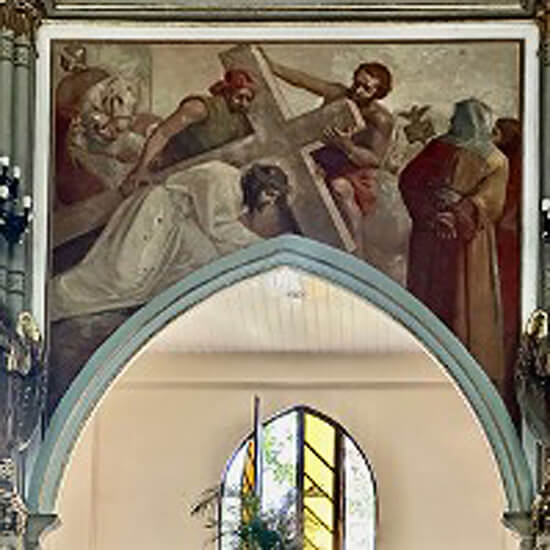
Father Maurus Cuachon, OSB, is the procurator and takes charge of caring for the assets of the abbey, including artworks. Rev. Pio Francisco, the sacristan of the abbey, also looks into the maintenance of these treasures. The community spearheaded restoration on the church structure and its art in the past. Father Maurus intimates that it is a long, costly process, but hopes they can pursue plans for a full conservation effort in the future, God willing.
He also notes that the purpose of sacred art is really to educate in matters of faith. It also becomes more relevant when students benefit from this rich, visual medium of instruction.
One might ask how the artist arrived at this sequencing of the artworks. With some reflection, the viewer might notice that the allegorical virtues lead the eye towards the altar, demonstrating to the faithful that the way to salvation comes through virtue, not a righteousness that comes from human effort alone, but formed humbly and ultimately through Divine grace.
The suffering of Jesus portrayed in the Way of the Cross, perfectly aligned with the allegories, seems to convey that virtue is necessarily accompanied by sacrifice—offering one the opportunity to share in both the passion and glory of the Lord. To be a witness requires with-ness, as the philosopher Peter Kreeft says. For the Benedictine, this translates to a steady companionship with Christ through the vicissitudes of life.
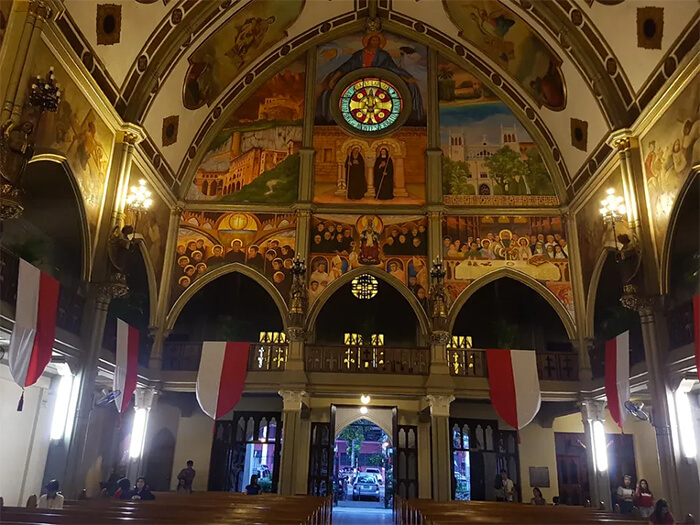
Pivoting toward the other end of the aisle, one now has a full view of the choir loft over which there is a more recent addition: a mural by the Italian artist Francesco Giannini installed in 2012 to fill the rear wall of the church. It documents the life of the Benedictine Order in the Philippines. The composition is divided into several parts: centrally there is the Risen Christ with St. Benedict and his sister St. Scholastica, while the surrounding images are an homage to the pioneering monks, eminent abbots, and St. Maximillian Kolbe, the martyr who died in Auschwitz. Kolbe visited here for a time. The holy men and women in the painting are honored with reverence and gratitude.
Depictions of the Benedictine monasteries in Italy, Spain and the Philippines complete the composition.
Asmaller artwork to the side, also by Giannini, pays tribute to three Benedictine monks formerly assigned to the abbey in Manila. They lost their lives as martyrs during the Spanish Civil War. Father Maurus shares that they could have escaped their fate had they remained in the Philippines. But they chose to return to Spain. Their sacrifice has elevated them to the company of the holy ones as Blessed Eugenio Erasquin, Blessed Santiago Pardo, and Blessed Domingo Caballe.
With rekindled spirit, one can make their way through the massive polychrome doors sculpted by Eduardo Castrillo, while statues of exquisite Carrara marble bid thee farewell. Stepping into the sunshine and looking out into Mendiola, it is hard to imagine how not too long ago this place of peace bore witness to much turmoil and unrest during the protest years. The abbey church at San Beda has remained, offering sanctuary and hope for almost a century to those who come here, lifting up the suffering spirit and renewing aspirations toward virtue.


